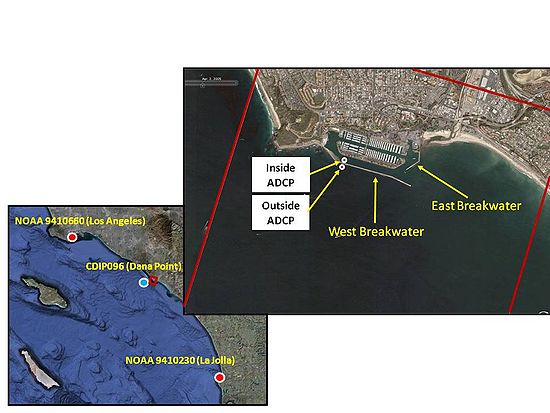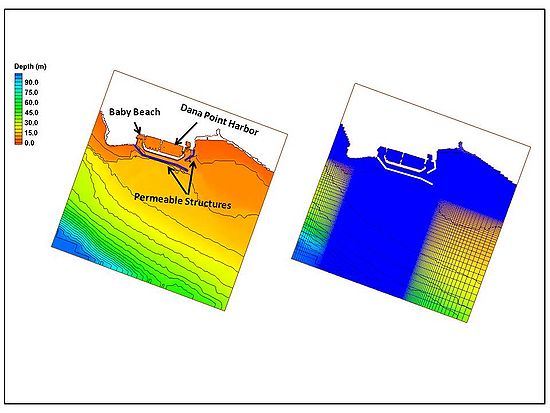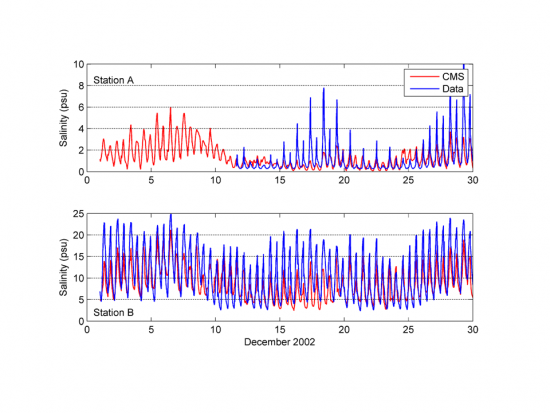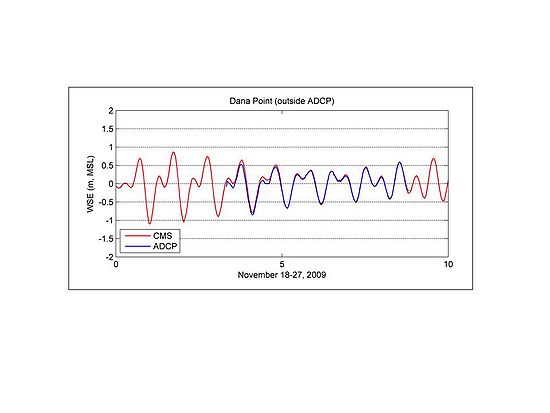Structure
Introduction
In coastal applications, it is important for hydrodynamic and sediment transport models to simulate wave transmission and flow penetration through rubble mound structures (d’Angremond et al. 1996; Garcia et al. 2004; Tsai et al. 2006). The present study applies the methodology simulating the permeability of rubble mound structures (Reed 2010) in the CMS to Dana Point Harbor on the southern California coast. The hydrodynamic calibration and sediment transport validation are conducted against the field measurements.
Study area and data collections
Dana Point Harbor is located in Orange County on the US Pacific coast, 40 miles southeast of Los Angeles, CA. The harbor is entirely manmade and is protected from ocean waves by a pair of riprapped breakwaters constructed in the late 1960s. The breakwaters, consist of a long shore-parallel West Breakwater of 5,500 ft and a shore-normal East Breakwater of 2,250 ft (Figure 1), were designed as permeable structures. As these structures can dissipate wave energy and reduce wave reflection, the current and sediment transport can pass through. As a result, fine sands are accumulated inside the West Breakwater and maintenance dredging is required periodically (County of Orange 2009).

A field data collection program was designed for this study. A hydrographic multi-beam survey for the underwater portion along with the above-water mapping via the LiDAR scanning technology for the breakwaters was conducted in October 2009 (Fugro West 2010). Bathymetric data were also collected in the marina basins, harbor entrance and nearshore areas outside the harbor. Two ADCPs were deployed from November 2009 through January 2010 to collect current and water level inside (without wave data collection) and outside (with wave data collection) the West Breakwater (Figure 1). Because of the instrument failure, only initial six days of data were recovered from the outside ADCP. In the last 20 years, Orange County has conducted three maintenance dredges to remove fine sand material that moved through and deposited on the harbor side of the West Breakwater. The dredged volumes inside the West Breakwater are approximately 25,000 cy in 1990, 35,500 cy in 1999, and 54,000 cy in 2009 (County of Orange 1990; 1999; 2009).
Methodology
In the CMS, both the West and East Breakwaters were specified as permeable structures, through which wave transmission, flow and sediment seepage were implemented. Figure 2 shows the CMS rectangular grid domain that consists of 399 ´ 327 cells surrounding Dana Point Harbor. The water depth ranges from 0 m at Baby Beach to 9 m at the harbor entrance channel inside the marina and increases to more than 10 m outside the West Breakwater. The offshore area further deepens to a few hundred meters and is open to the Pacific Ocean. A variable-resolution grid system was created to discretize the entire harbor and the offshore region, which permits much finer grid resolution (5 m) in areas of high interest such as the harbor and the breakwaters. The model domain extends approximately 5 km alongshore and 4 km offshore, and the offshore boundary of the domain reaches to the 300‑m isobath.

Results and discussion
The CMS simulations were conducted for a 10-day period from 18 to 27 November, 2009, which covers the beginning stage of the inside ADCP survey and the entire record of the outside ADCP survey. The calculated wave parameters are compared with the measurements at the outside ADCP station (Figure 3). The mean significant wave height is 0.75 m. Wave heights for the 10-day period are mostly less than 1.0 m. The mean wave period is 13.5 sec, and the predominant wave direction is west-southwest. Comparing to the 2008 annual data, the 6-day period represents a slightly lower wave height and a typical wave direction in November. The wave transformation results show a good consistency with the measured wave parameters. An underestimate of wave height in the first couple of days could be related to the wind forcing since the wind data used were obtained from a different buoy.

Figure 4 shows the comparison of calculated and measured WSEs at the outside ADCP station from 18 to 27 November 2009. During this neap tidal period, the CMS results well reproduce the tidal signals displayed in the 6-day WSE survey outside of the West Breakwater.

References
Buttolph, A. M., Reed, C. W., Kraus, N. C., Ono, N., Larson, M., Camenen, B., Hanson, H., Wamsley, T., and Zundel, A. K. (2006). “Two-dimensional depth-averaged circulation model CMS-M2D: Version 3.0, Report 2, sediment transport and morphology change,” Coastal and Hydraulics Laboratory Technical Report ERDC/CHL-TR-06-7. U.S. Army Engineer Research and Development Center, Vicksburg, MS.
County of Orange. (1990). “Plans and special provisions for the maintenance dredging at Dana Point Harbor,” funded by Harbor, Beaches and Parks, County of Orange.
County of Orange. (1999). “Plans and special provisions for the maintenance dredging at Dana Point Harbor,” funded by Harbor, Beaches and Parks, County of Orange.